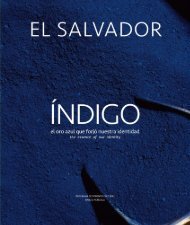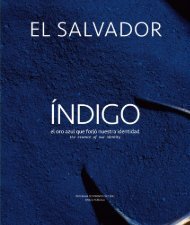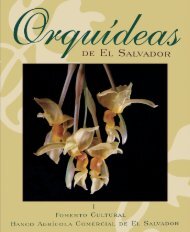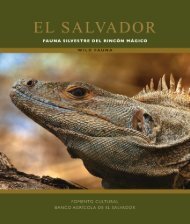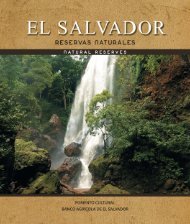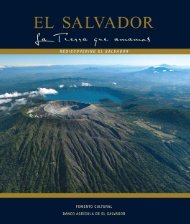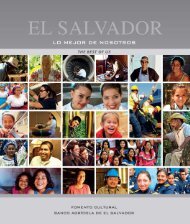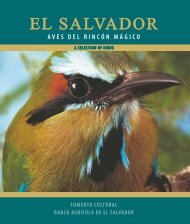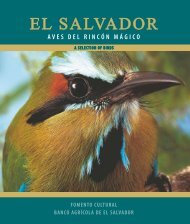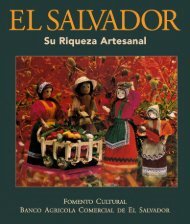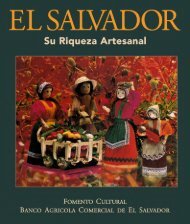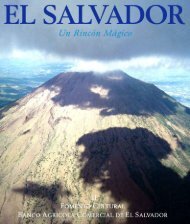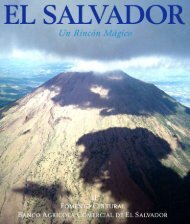Monumentos y Esculturas
Create successful ePaper yourself
Turn your PDF publications into a flip-book with our unique Google optimized e-Paper software.
Detalle grupo escultórico<br />
Alegoría de la Constitución de 1950.<br />
Detail sculptural group.<br />
Alegoría a la Constitución de 1950.<br />
ESCULTURA DE AUTOR<br />
Entre 1950 y 1970, El Salvador entra en una etapa de refundación<br />
del Estado. La revolución que entre 1944 y 1948 termina con<br />
el periodo militar de Maximiliano Hernández Martínez (1931-1944)<br />
representa también un periodo de renovación estético para la<br />
ciudad.<br />
Por mandato del nuevo gobierno, se construirán tres de las<br />
esculturas monumentales más representativas de la ciudad:<br />
el Monumento a la Revolución de 1948, inaugurado en 1955; el<br />
Monumento a la Constitución de 1950, inaugurado en 1956, y el<br />
Monumento al mar (1970).<br />
En esta etapa se desarrolla la escultura artística de autor;<br />
identificada por una búsqueda de un nuevo lenguaje escultórico:<br />
no hay más figuras gráciles o épicas del neoclásico, y el bronce<br />
y el mármol dejan de ser el soporte creativo.<br />
La piedra será el medio en el que se esculpe este periodo y su<br />
uso obedecerá a intereses identitarios, como la búsqueda de los<br />
elementos nacionales. El cambio del mármol por la piedra oscura<br />
será también un elemento revolucionario que dará un nuevo<br />
rostro a la cultura salvadoreña<br />
Esta etapa escultórica tendrá dos influencias preponderantes:<br />
La revolución mexicana y el movimiento muralista de Diego<br />
Rivera y David Alfaro Siqueiros, que hace una nueva lectura del<br />
cuerpo latinoamericano en su espacio; y la influencia del espanol<br />
Benjamín Saúl y sus figuras semiacuáticas, semihumanas, en<br />
constante movimiento.<br />
La característica más importante de este momento es la lectura<br />
del cuerpo en la sociedad, representa finalmente al pueblo:<br />
mujer, hombre, obrero, niño o mito.<br />
SCULPTURE OF AUTHOR<br />
Between 1950 and 1970, El Salvador enters a stage of reorganizing<br />
the State. The revolution, that between 1944 and 1948 ends with<br />
the military period of Maximiliano Hernández Martínez (1931-<br />
1944), is also an aesthetic renewal period for the city.<br />
By mandate of the new government, three of the most<br />
representative monumental sculptures of the city were erected:<br />
El Monumento a la Revolución de 1948, which opened in 1955; El<br />
Monumento a la Constitucion de 1950, which opened in 1956;<br />
and the Monumento al Mar (1970).<br />
At this stage is when the artistic sculpture of author develops,<br />
identified by a search for a new sculptural language: there are<br />
no more graceful figures or neoclassical epic, and bronze and<br />
marble are no longer the creative support.<br />
The stone is the medium used for sculpting during this period<br />
and its use obeys to identity interests, as the search for national<br />
elements. The change of marble for dark stone will also be a<br />
revolutionary element; which would give a new face to the<br />
Salvadorean culture.<br />
This sculptural stage will have two dominant influences: the<br />
Mexican Revolution and the Muralist Movement by Diego<br />
Rivera and David Alfaro Siqueiros, which made a new reading<br />
of the Latin American body in its space, and the influence of<br />
Spanish Benjamin Saul and his semiaquatic figures, half-human,<br />
in constant motion.<br />
The most important feature of this moment is the reading of<br />
the body in society; it ultimately represents the people: woman,<br />
man, worker, child or myth.<br />
92 93



